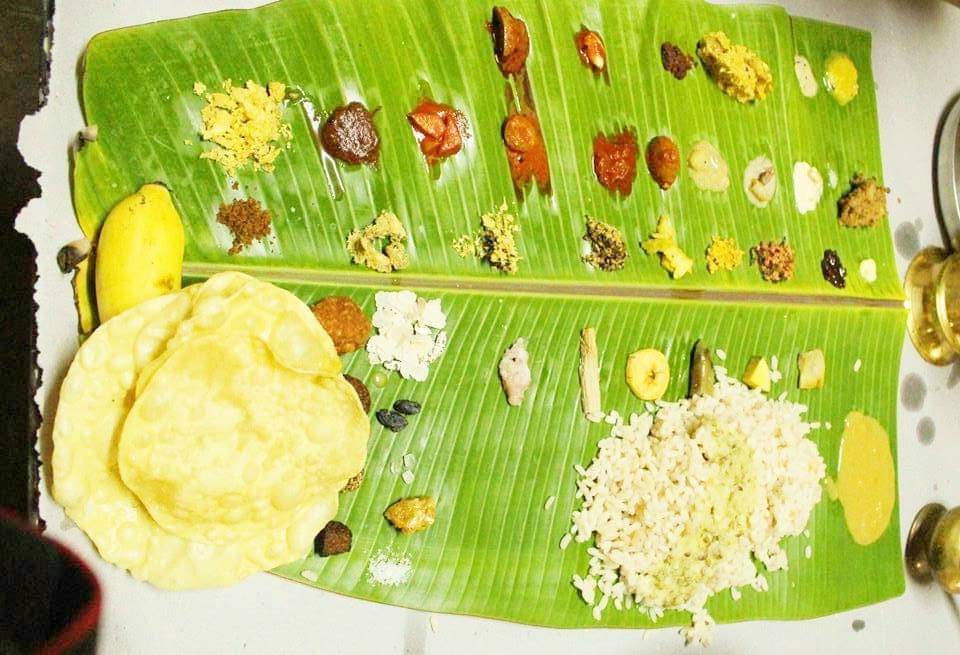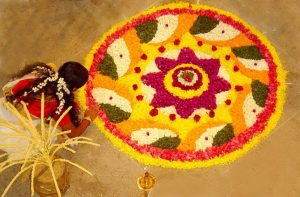But with or without non-veg dishes, it is a feast that Malayalees in the state and across the globe eagerly look forward to.

The many elements of the traditional Onam sadhya. (KB Jayachandran/South First)
Almost a decade has gone by since noted CPI(M) intellectual K E N Kunjahammad stirred a hornet’s nest by writing an article that said there would no breach of convention if Kaala (beef) is served along with Kaalan (a traditional vegetarian dish made with raw banana and thick curd) on banana leaf plates during Thiru Onam.
Many party leaders disapproved of the argument, saying it was an unwarranted claim providing the Sangh Parivar with another tool to project the CPI(M) as a collective of people targeting Hindu culture and tradition.
However, Kunjahammed received support from the state’s Dalit and backward communities, who have a long tradition of adding non-vegetarian accompaniments to the Thiru Onam sadhya, usually an all-vegetarian, multi-course feast.
Though Kunjahammed wrapped up his arguments after the disapproval of his party leaders, the debate over the vegetarian character of Onam sadhya continues, with academics and historians occupying the stage.
While Malayalees worldwide prepare to relish Onam sadhya on Thursday, September 8, the issue is back in public focus, with Sangh Parivar groups urging cadres to keep intact the vegetarian character of sadhya.
For them, it’s a matter of purity and tradition in a state where people, cutting across politics and religion, eat a lot of meat and fish varieties daily.
“Onam is largely a harvest festival, and tradition has taught us to celebrate it with vegetables the farmers grow. The festival is, in fact, a salute to the farmers who toil on the soil to feed us. If you are truthful and committed to the spirit of the harvest festival, non-veg dishes must be avoided in the menu,” KP Sasikala, president of Sangh Parivar affiliate Hindu Aikya Vedi, told South First.
But historian Malayinkeezhu Gopalakrishnan countered this claim, saying the Onam sadhya has different regional variations in the state; and across north Kerala, for instance, the feast includes meat and fish. He also pointed out that Onam celebrates the legend of Mahabali, an Asura king, who was most likely a non-vegetarian.
“Whatever be the controversy, it’s unthinkable for us in Kannur to have the feast without a fried piece of chicken and fish cooked in coconut milk. Non-vegetarian Onam sadhyas have been prevalent in Kannur and Kasargod districts for a long time. I have been relishing them from my childhood,” said R Rajasree, a noted Malayalam novelist who hails from Parassinikadavu in the Kannur district.
Irrespective of the controversy, Malayalees attach extreme importance to the Onam feast and its number of dishes. People still cite the old Malayalam saying: “Kaanam Vittum Onam Unnanam”, which, roughly translated, means, “relish the Onam feast, even if you have to sell your property for it”.

The flower carpet being arranged for Onam at a house in Thiruvanathapuram. (KB Jayachandran/South First)
This year, the enthusiasm for the festival is markedly high; the three previous years saw the coronavirus pandemic casting a baleful shadow over the festivities. And the year before that, it was the big flood that proved a wet blanket.
Though Thiru Onam is still a few days away, offices, public establishments and social organisations have already started conducting Onam sadhyas for their staff and members.
Many schools have started serving the feast to their students. Hotels and restaurants across the state have started a competition to ensure the best Onam feast for visitors, especially those from outside the state, like tourists and non-Malayalees.
According to academic and writer J Devika, the Onam sadhya was a modest affair in southern Kerala until the 1960s, with a maximum of nine dishes — a far cry from today’s standard of 24. However, the influence of neighbouring Tamil Nadu has expanded the scope and taste of the sadhya, with sambar and avial occupying prime places along with rice.
With or without non-vegetarian dishes, an Onam sadhya will be incomplete without banana chips, pappadom, sweet and sour pickles, aviyal, sambar, dal, ghee, rasam, buttermilk, chutney made from grated coconut, and several payasams eaten on their own or mixed with a small, ripe plantain.
In southern Kerala, only a single pappadom is usually served with the sadhya.
But with last week’s video of a fight at a marriage feast at Haripad near Alappuzha over the denial of an extra papad going viral, many eateries across the state are promising more than one pappadom to those who partake of the sadhya at their establishments.

May 18, 2024

May 17, 2024

May 17, 2024

May 17, 2024

May 17, 2024

May 16, 2024